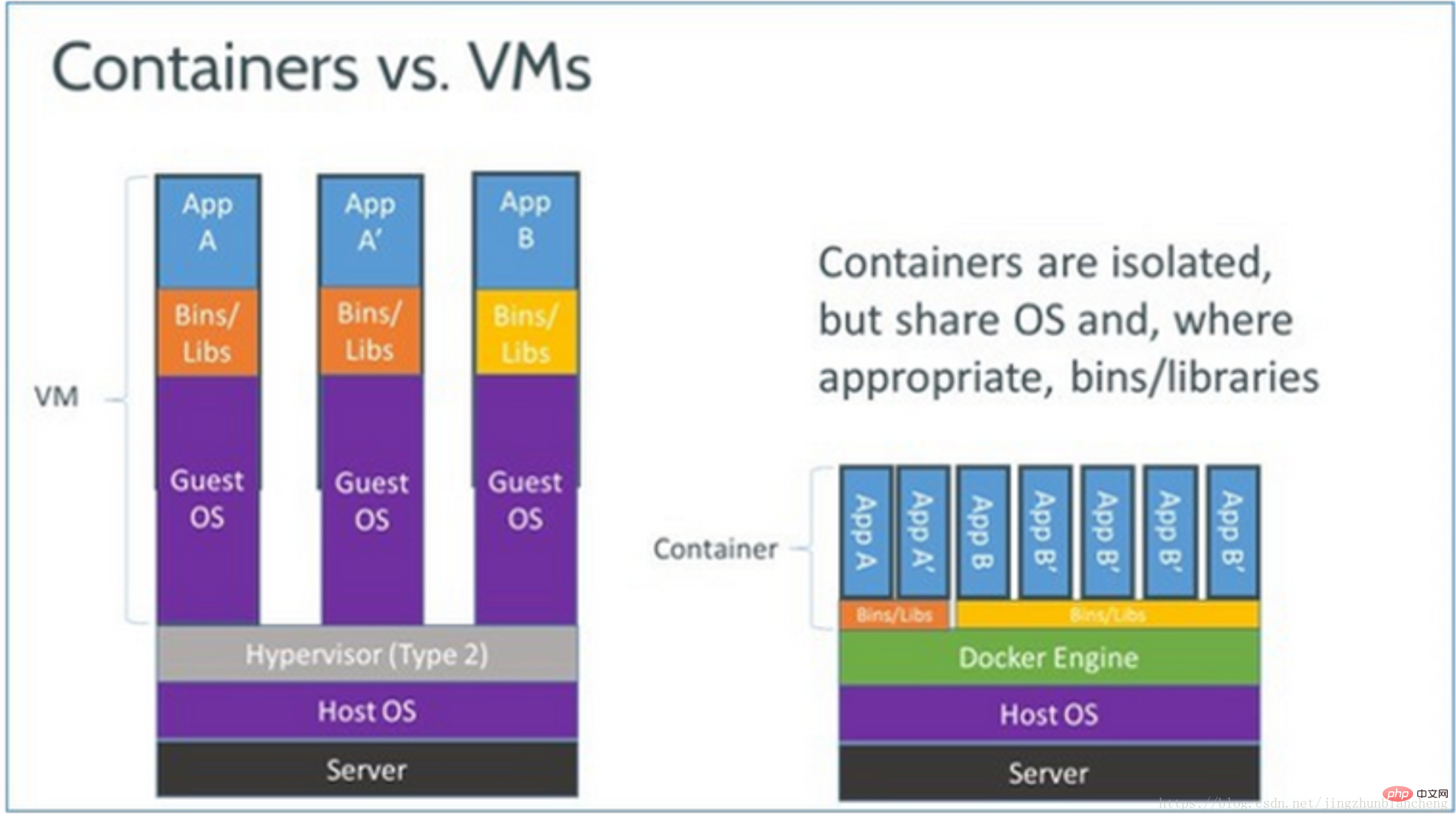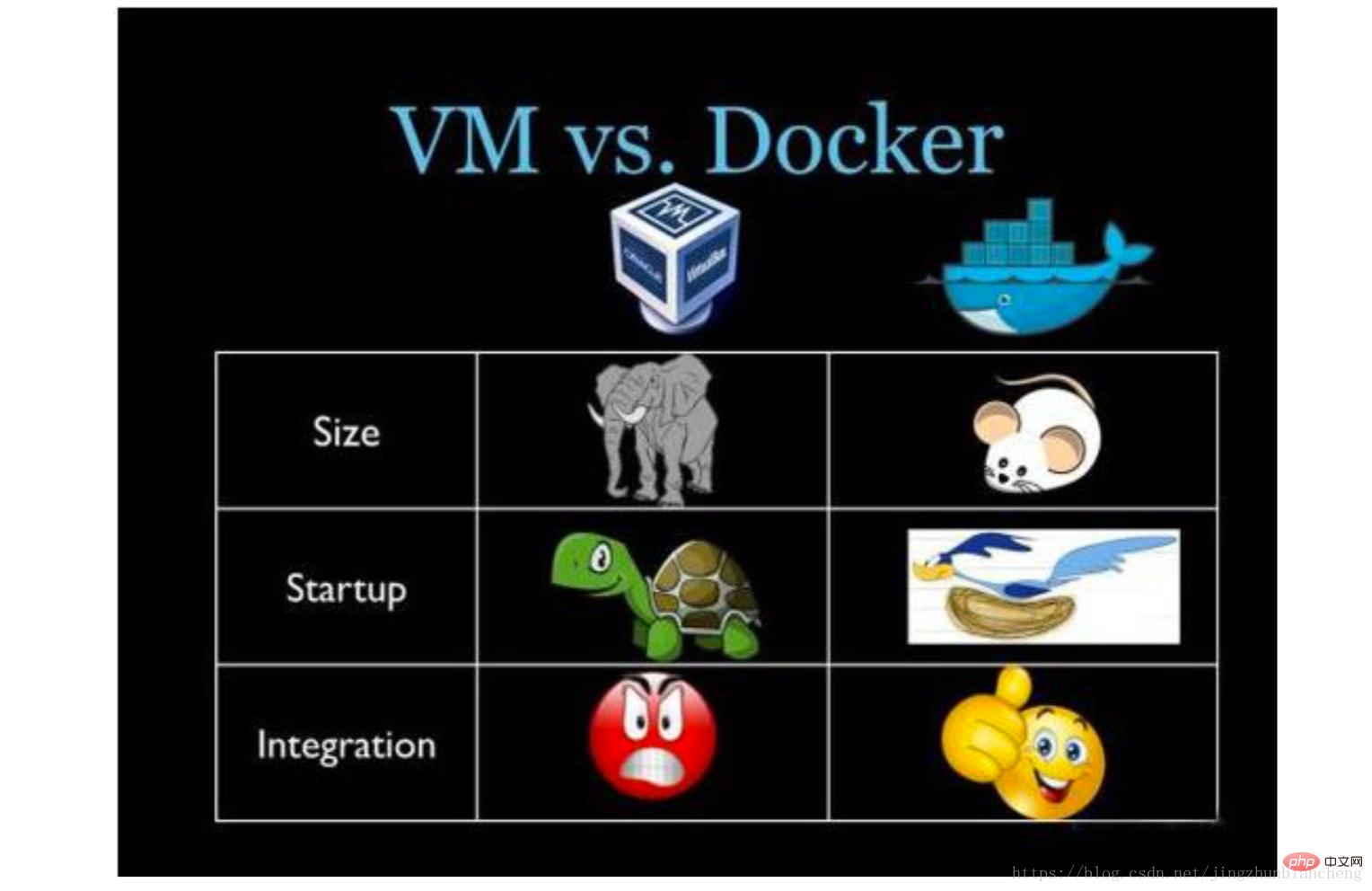
Difference: 1. Docker container provides process-based isolation, while VM virtual machine provides complete isolation of resources; 2. Docker uses the kernel of the host operating system, while VM virtual machine uses an independent kernel; 3 , Docker's startup speed is on the second level, and VM is on the minute level; 4. Docker's integration is better than VM.

The operating environment of this tutorial: linux5.9.8 system, docker-1.13.1&&VMware Workstation16.0.0.16894299 version, Dell G3 computer.
1. Essential difference:

VM (VMware) creates a virtual layer, virtualized operating system, and virtualized warehouse based on the host machine and host machine operating system, and then installs the application;
Container (Docker container) creates a Docker engine on the host machine and the host machine operating system, and then installs the application based on the engine.
Docker containers provide process-based isolation, while VM virtual machines provide complete isolation of resources. Containers use the kernel of the host operating system, while virtual machines use a separate kernel.
2. Differences in use:
 Size:
Size:
1. Ubuntu occupancy in the virtual machine Memory:
## Docker creates the Docker engine on the host machine's operating system and directly calls hardware resources on the host machine's operating system instead of virtualizing the operating system and hardware resources, so the operation speed is fast. This actually installs an ubuntu virtual machine and pulls a Docker ubuntu image file. You will know after running it. The difference is obvious. The startup speed of Docker is on the second level, and the VM is on the minute level: virtual It takes more than 2 minutes to start the computer, but Docker only takes 2 seconds.
This actually installs an ubuntu virtual machine and pulls a Docker ubuntu image file. You will know after running it. The difference is obvious. The startup speed of Docker is on the second level, and the VM is on the minute level: virtual It takes more than 2 minutes to start the computer, but Docker only takes 2 seconds.
Integration:
Docker’s integration is better than VM. 
1)
Users can "Dockerize" their programs in just a few minutes. Docker relies on the "copy-on-write" model, which makes it very fast to modify the application. It can be said that it reaches the realm of "the code is changed as you please".
Afterwards, you can create a container to run the application. Most Docker containers start in less than 1 second. Since the overhead of the hypervisor is removed, Docker containers have high performance. At the same time, more containers can be run on the same host, allowing users to make full use of system resources as much as possible.
2)
Logical classification of responsibilitiesUsing Docker, developers only need to care about the applications running in the container, while operation and maintenance personnel only need to care about how to manage the container. The purpose of Docker's design is to enhance the consistency between the development environment where developers write code and the production environment where applications are deployed. Thereby reducing the kind of "everything is normal during development, it must be an operation and maintenance problem (the test environment is normal, if there is a problem after going online, it must be an operation and maintenance problem)" 3)
Fast and efficient development life cycleOne of the goals of Docker is to shorten the cycle of code from development, testing to deployment and online operation, making your application portable, easy to build, and Easy to collaborate. (In layman’s terms, Docker is like a box that can contain many objects. If you need these objects, you can directly take them away from the big box without taking them one by one from the box.)
4)Encourage the use of service-oriented architecture
Docker also encourages service-oriented architecture and microservices architecture. Docker recommends that a single container only runs one application or process, thus forming a distributed application model. Under this model, applications or services can be represented as a series of internally interconnected containers, thus enabling distributed deployment Application, extension or debugging of the application becomes very simple, while also improving the introspection of the program. (Of course, you can run multiple applications in one container)
Recommended learning: "docker video tutorial"
The above is the detailed content of What is the difference between vm virtual machine and docker. For more information, please follow other related articles on the PHP Chinese website!
 The difference between k8s and docker
The difference between k8s and docker
 What are the methods for docker to enter the container?
What are the methods for docker to enter the container?
 What should I do if the docker container cannot access the external network?
What should I do if the docker container cannot access the external network?
 What is the use of docker image?
What is the use of docker image?
 js method to get array length
js method to get array length
 The difference between rest api and api
The difference between rest api and api
 Install and configure vnc on ubunt
Install and configure vnc on ubunt
 How to resize pictures in ps
How to resize pictures in ps